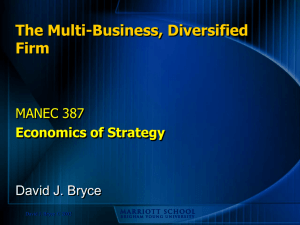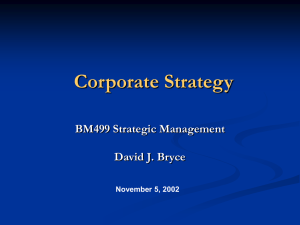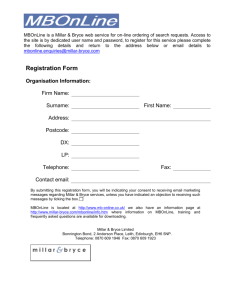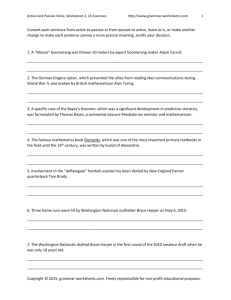Multi-Unit Firms - BYU Marriott School
advertisement
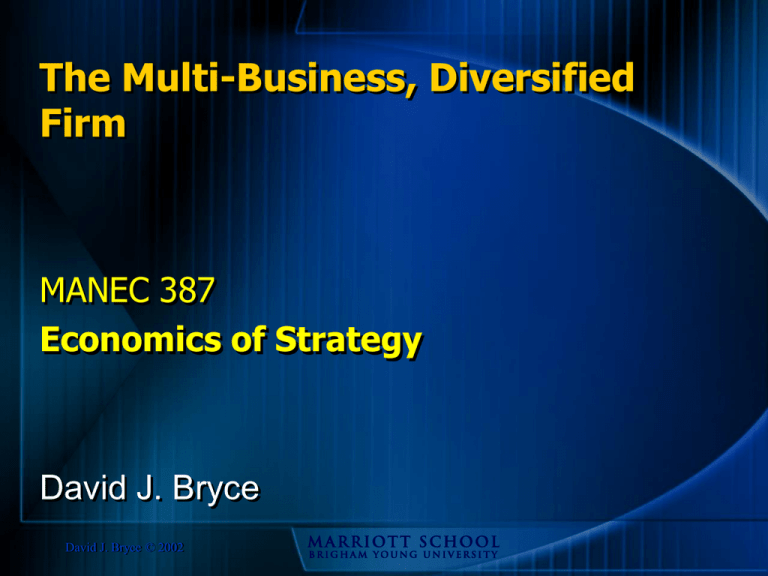
The Multi-Business, Diversified Firm MANEC 387 Economics of Strategy David J. Bryce David J. Bryce © 2002 Corporate vs. Business Unit Strategy • Business Unit Strategy – To whom will we sell, for what price? – How will we source, manufacture, distribute, etc. our product? • Corporate Strategy – What business(es) should we be in? – How will we get in (or out) of them? – How will we coordinate or integrate businesses to create value? David J. Bryce © 2002 Adapted from M. Porter, 2001, HBR Corporate-Level Strategy and the Multi-business Firm • Corporate strategy is action taken to gain competitive advantage through multiple business units • Value is created through the configuration and coordination of multi-business activities David J. Bryce © 2002 Scope of the Firm “Horizontal Integration” output-products Prod./Ind. A Prod./Ind. B Prod./Ind. C Sales Sales Sales Distrib Distrib Distrib Manuf. Manuf. Manuf. ... Input-products “Vertical Integration” Vertical Scope Horizontal Scope Sales Sales Distrib Distrib Distrib Manuf. Manuf. Manuf. ... David J. Bryce © 2002 Sales Wal-mart Prod./Ind. A Prod./Ind. B Prod./Ind. C Sales Sales Sales Distrib Distrib Distrib Manuf. Manuf. Manuf. ... Input-products Vertical Scope output-products Horizontal Scope Sales Sales Sales Distrib Distrib Distrib Manuf. Manuf. Manuf. ... David J. Bryce © 2002 GE Horizontal Scope Aircraft Engines Prod./Ind. C Sales Sales Sales Distrib Distrib Distrib Manuf. Compressors Sales Manuf. Manuf. Sales Sales Distrib Distrib Distrib Manuf. Manuf. Manuf. Input-products Vertical Scope output-products Refrigerators ... ... David J. Bryce © 2002 Why Diversify? • Secure Market Power – Cross-subsidization, mutual forbearance, reciprocal buying – Shown to be an incomplete, if not an incorrect view • Mitigate Business (Cycle) Risk – Perspective from finance – Few firms are just “portfolio” investors David J. Bryce © 2002 Why Diversify? • Achieve Efficiency (or “Synergy”) – Pursue related or complementary activities – Most common type of diversification – Associated with higher levels of performance than previous two types • Dynamic Learning – Related to the efficiency motivation – Firms invest in activities that leverage existing skills and knowledge – Firms introduce new activities to build skills and knowledge – Objective is to develop a “capabilities portfolio” that is ready for new opportunities when they emerge David J. Bryce © 2002 Transaction Costs and Diversification • Hierarchical organization (as within a firm) is a governance mechanism that reduces the costs of transactions that would otherwise occur across markets or not at all – E.g. Complex contracting environments (recall our discussions on Hold-up) – Contracting for specific assets – Certain types of knowledge assets David J. Bryce © 2002 How to Choose Industries/Products for Expansion 1. Strategically Important 2. Strategically Related; i.e. commonality in one of the following: 1. 2. 3. 4. 5. Customers Channels Inputs Processes Market Knowledge David J. Bryce © 2002 Evaluating Diversification • How can diversification create value? – Economies of scope – Learning • How can diversification dissipate value? – Bureaucratic costs – information overload, coordination limitations – Over-extension for management know-how, financial, or other resources – Empire building without incremental value-add David J. Bryce © 2002 Sequential Entry and Dynamic Learning: Example Texas Texas Instruments Instruments Semiconductors (3674) Electronic Computers (3571) Software (7372) Search & Navigation (3812) Electronic Computers (3571) IBM IBM Computer Storage Devices (3572) Computer Terminals (3575) Computer Peripherals (3577) Source: COMPUSTAT Business Segment Files, 1977-1996 David J. Bryce © 2002 Software (7372) Semi-conductors (3674) Patterns of Historic Entry in Industries Related to Semiconductors, 1977-1996 Process Control Instruments (3823) Electronic Capacitors (3675) *** (*) *** (*) Search & Navigation Equip. (3812) ** (*) * Radio/TV Communication Equip (3663) * p<0.10 **p<0.005 ***p<0.001 David J. Bryce © 2002 * * Electronic Computers (3571) * * Printed Circuit Boards (3672) * Computer Storage Devices (3572) *** (*) (*) Electronic Components (3679) *** (***) * * * Semiconductors (3674) * Engineering Services (8711) * Computer Peripherals (3577) Special Industries Machinery (3559) Instruments to Measure Electricity (3825) Patent Owners & Lessors (6794) Summary and Takeaways • Corporate Strategy is about structuring a portfolio of businesses that hang together and make strategic sense • It is sometimes motivated by economizing on transaction costs • Other (strategic) motivations include dynamic learning, efficiency, or sometimes market power and risk management • Diversification is not a fail-proof strategy David J. Bryce © 2002
